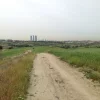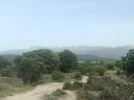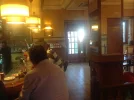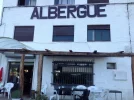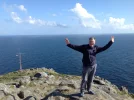Day 32 Finisterre, the last post, and onwards ....
Old habits die hard. I was wide awake around 6.00am and checked the weather forecast. Rain was on its way and it had been raining overnight, so that ruled out walking to Muxia and I didn't fancy sitting around cafes in Finisterre in poor weather. After going for a walk, I found out by accident (it wasn't on any timetable I saw) from a group waiting that a ’fast’ bus left for Santiago but you had to change in Baio - the connecting bus was waiting in Baio when we arrived) at 8.40am, which meant I should be able to get a connecting bus at midday to Porto, if a seat was available. Getting reliable and clear local bus info outside of large cities is probably more difficult in Spain than anywhere in the world, and that includes India or any other third world country you care to name! I would certainly have had a rest day in Finisterre if the weather had been better, as it is a quiet, pretty place with great beaches close by, and if I could have worked out how to get to Muxia by bus, I probably would have gone there. But new adventures await!
The decision was made so went back to the hotel, packed, grabbed a coffee and set off. I’ve now got about two weeks to do a Porto, Lagos, Seville, Córdoba, Malaga, Gibraltar tour. This will be done using busses, trains and blablacar.com but no walking, although I do want to look at the National Park down South near Lagos in Portugal and the Fisherman’s Trail. I think it lacks the albergues that Spain has so probably won’t be there long.
So, this post is the last one for this Camino de Madrid thread. I am very, very glad I did this Camino. It has generally been brilliant fun. It is so easy to walk from Madrid to Finisterre, much, much easier than when you are sitting at home planning it, especially if you have never done one before. The yellow arrows are everywhere and it is incredibly hard to get lost or even take a wrong turning. The albergues are everywhere and there are often far more than in any guidebook - it might be worth tracking down an online up-to-date albergue list before you go - and in May up to mid-June, there was absolutely no problem getting a bed anywhere. I never booked ahead or had to ring round. You just don’t need to at that time of year, although the last part of the Camino de Frances was getting busier by the time I finished.
I think in 31 days I had a total of five minutes of rain, and wore the poncho for about two minutes and that was on the last day of walking yesterday! I used the light sleeping bag (goes down to minus 4 degrees C) for about 15 of the 31 days and used blankets provided for the other days, and had two very light fleeces for mornings and sometimes evenings. I would take the bags and both light fleeces again - you need them. I never had any problems with bedbugs but met one girl who had a very serious attack over her face and neck, but it was in a hotel not an albergue!
I'm reasonably fit, but the distances can be long and hard and it is difficult to see how most people can train for the 8 or 9 hours of walking they will do each day before they arrive. The distances can also be short if you want. I could easily have taken twice as long and stopped off at more places. I typically walked between 25 and 30 kms a day, starting around 6.30am and finishing around 3.00pm and took a few breaks in between. Sometimes, I walked 40 kms and for 12 hours, and sometimes just 15 kms and for 5 hours. Needless to say, good, comfortable walking shoes and socks, fully broken in, are vital. Take advice about the size of the shoe, which should be at least a size bigger than your foot size. You also need to know how to deal with blisters and how to avoid them in the first place so do your homework. I found a roll of plaster and some ankle bandages, which you can buy in large supermarkets, brilliant as I could make a cushion for my heels and plaster it on, and apply cushions to toes when a plaster was to thin. Having ’bruised’ heels were my biggest problem for most of the trip. It felt at times like someone was digging a sharp needle into my heels, especially at night when I'd stopped walking, but you have to keep going and ignore the pain! Dealing with a potential blister the moment you felt a problem was really important. Stop and deal with it before it becomes a much bigger problem. Some dissinfectant wipes were also light to carry but useful.
When stopping at an albergue, I would typically have a shower first, wash out the walking t shirt and anything else that needed it, hang them up to dry, have a rest for an hour or two, then eat, drink, Internet stuff, socialising and bed between 9.00pm and 10.00pm. Snoring in dorms can be a huge problem at the start, but you get used to it after a few weeks. You really do need to bring some seriously good earplugs, though, the best money can buy! I always found the facilities (toilets, showers, kitchen, washing facilities etc) at albergues to be fine and usually excellent. I stayed in hotels all costing between 20 and 30 Euros on 4 nights, at the start in Madrid, at the end in Finisterre and in Segova and Leon. The odd stay in and privacy of a hotel keeps you normal! Wifi is everywhere in albergues and cafes and generally very fast. I had only a few days without wifi or where it was poor. I also did not buy or need a Spanish SIM card for my phone. I could have left my phone at home, although I did listen to music on it. I used my iPad for everything, including taking photos. I think an iPad mini or a seven inch tablet would be perfect here.
You don’t need water bottles or water bladders. Most people just bought water from supermarkets and refilled them at fountains. Being aware of the distances between likely water and food sources is important as on very hot days, running out and becoming dehydrated is possible. On the other hand, carry too much and you are adding a couple of kilograms to your pack weight. Take a good, wide brimmed floppy hat to protect you from the sun.
I started the Camino with about 8 kgs on my back, and an extra amount for water and snacks. I quickly threw away excess clothes, deodorants etc so I was carrying between 6 and 7 kgs plus liquid. It is worth spending money on extra light equipment where possible as the weight adds up. I used a small bottle of shampoo for hair, soap, cleaning clothes and washing out the chocolate that had melted in a pocket in rucksack! On the Camino de Frances, there is the option of forwarding your entire pack from the hostel you are in to a named one further along the path. It seemed to cost about 7 Euros a day, was efficient and ideal for some people. You simply filled out details on an envelope, popped the fee in and left it at the hostel. You just carried a day sack. I never tried it myself as I wasn’t bothered by the weight I had to carry but I can see its benefits. On the plus side, I’ve lost about 4kgs of blubber on the walk and feel super-fit.
For me, the Camino de Madrid was just outstanding. I met 3 walkers in two weeks, the albergues were usually empty, I had to speak Spanish and there were long periods on my own, in the sun. The scenery changed every few days, and was fantastic, the villages pretty and everyone I met was super helpful. No one in Spain, judging by this route, speaks English, so learn some basic Spanish before you come. Have key questions and phrases written down to show people. Use Google Translate in wifi areas. The Camino de Frances did grow on me, but it was quite a shock at the start, as suddenly, I went from meeting 3 people in 2 weeks to seeing at least 100 people a day! It is very social, I met some great people, had really good communal dinners and drinking sessions. It is worth looking out for albergues that do communal dinners by the way, as I found everyone to be fun, with great food and good value. The Camino de Frances is just different to the Madrid Camino. The only thing I really didn't like was the last 100 kms into Santiago - I would definitely not do that section again. Too many roads, too much traffic, too much of a dash from one place to the next. It was exciting arriving in Santiago after a month of walking, but for me, there is only a day needed to see it, at the most. It is similar to other places like Leon.
If you have the time, walk on to Finisterre. That was three brilliant days, with great scenery, excellent company and seeing the sea is surprisingly moving! Next time, I will spend more time in the Finisterre and Muxia area, for sure. There are some other walking paths to be had as well.
Next time? No doubt about it! I think the Seville to Santiago walk is on the cards and certainly the Portugal Camino so look out for a thread on these walks next May (unless I am bored in September). I would do the Madrid Camino again without a doubt and perhaps even the whole of the the Frances route one day. It would be fun to bring a bike as well.
I hope that those of you planning your own Camino have found these day-by-day posts helpful, as I found the threads posted before I went helpful. It has been fun writing them and reflecting on each day and the overall trip. If you are still not sure about doing a Camino, whether you are fit enough, or if you will cope, or if you can live in albergues, my advice would be to just go for it. I never met a single person on the entire trip that regretted doing it.
Yours
Dave






